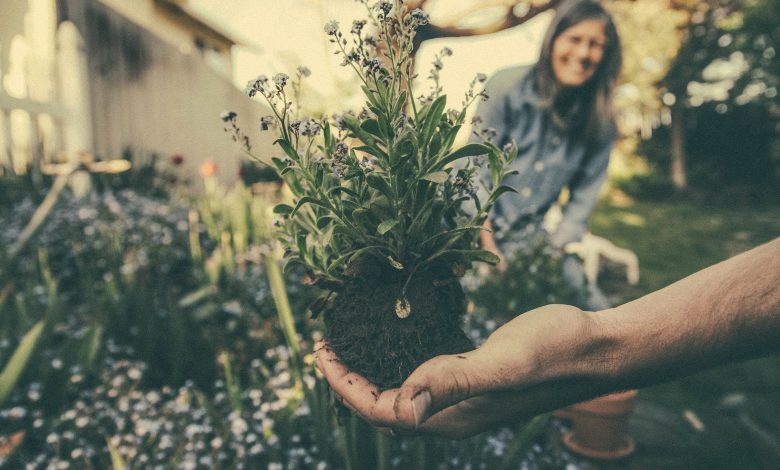How to Bring Your Garden When Moving

Unfortunately, there comes a time when many people involuntarily say goodbye to their garden, regardless of all that went into getting it where it is today. The fact is that not everyone permanently resides at locations where they’ve worked on gardens. However, it doesn’t mean you have to part with your plants.
It’s also possible that you just want to change the flowers’ location. You could simply have set up a greenhouse that you want your beautiful flowers to occupy. While the possibility exists, you should note such a move is much less likely to cause a stir.
This article is not just about the flowers that were planted in pots and somewhat simple to move. You can apply what you’re about to learn to your flowers that you planted in the ground so that you don’t need to leave them.
Preparing for the Move
Which Plants are Worth the Hassle?
In a perfect world, you’d move all your plants to the new area. However, when you are ready to change your location, you may find that such a feat is much easier said than done, which makes it very impractical to move everything. Before you begin, you should know that money and a great amount of effort tend to be required to move your flowers.
The nature of plants makes them some of the hardest things to move with, so there’s no surprise in the kind of costs that you’re likely to incur as you try to move. This means that you must make serious decisions on which plants are important enough to you to be worth the hassle.
Whenever you can, you are advised to simply travel with cuttings and seeds. Of course, having the whole plant from your whole location means that you can simply pick up from where you left off. Be that as it may, you need to consider the most practical way to move based on the kinds of flowers and the number of flowers that are in your garden.
Another advantage of growing this route is that the property that you’re leaving doesn’t have to end up looking bare and devoid of life. Not everyone cares about the place that they’re leaving, but depending on the kind of person you are, it may bother you to leave your old home looking so lifeless. If you do feel that way, this is a solution that everyone can get behind.
Consider the New Conditions
If everything were to go the way that you wanted it to, your new location would be just as suitable for your flowers as the old one was. Such a situation is not impossible, but unless you move into an area with the same kind of climate, you’re unlikely to get so lucky.
It’s always important to do some verification before you decide to drag flowers along that you may end up torturing. Remember that, even if a plant can survive in conditions that are less than ideal, there is an undue amount of stress that is put on it in the process. This prevents it from being as strong as it should be, which makes it more susceptible to pests.
First, you should check in with the USDA zone map to see who your plants are likely to fare in the area. Next, you need to verify what the climatic and soil conditions are at the new location. If your garden is filled with rich loam and you end up moving to a place that has nothing but sand, then clearly, your flowers may be on a one-way trip to destruction.
Apart from the conditions and the zone check, you should also check to ensure that the plant “imports” that you are doing are allowed into the state that you’re moving to (this is, of course, if your move is one that is out of state).
Who is Moving Your Plants?
The chances are that you don’t have the facilitates to move the plants on your own. Therefore, you need assistance from the movers. This is naturally expected, and the reason why you hired movers, right?
You don’t have the facilities to move the furniture either, yet the movers seem to handle that just fine. This is typically when you realize that you’ve probably made a big mistake when you expected that they would take your flowers too. What you may not know is that most moving companies don’t transport flowers.
It’s important for you to verify if the option that you are considering is one that is likely to help you in that regard. Note, however, that if you can’t get your regular mover to give your precious flowers a lift, there are specialty movers. These companies exclusively exist to move items that the regular movers are not willing to. Flowers are perfect examples of things that you can get specialty movers to take care of for you.
All you need to do is do some research to see what your options are before you commit to anything. Note that some of these companies also provide insurance policies in case you find yourself in a position where some form of harm befell your flowers during the trip. Be sure to ask about such offerings if they aren’t communicated to you. It’s best to know where you stand before an incident happens rather than afterward.

Choose Your Season
This is more important than many people think. When you decide to move a plant, there is obviously a risk that it doesn’t survive the move. There’s a reason plants tend to not be disturbed after a certain time has passed.
While you run this risk once you attempt the process, the level of risk doesn’t always need to be a high one. This is because it is best for you to move your flowers in either early spring or late autumn. While there are few flowers that don’t fall under this category, most plants are more receptive to environmental changes during those times.
This is because the plants have stopped growing. The dormant state that they enter provides a window for you to place them in new conditions for them to start growing again. The flowers usually adapt much better to new surroundings when people choose to move them during such periods.
Of course, not everyone has the luxury of choosing when they move based on what is best for their flowers. There are many reasons why you may be moving, and convenience to your flowers is not always something that can make your priority list.
So,if you can’t stick to the windows that are stated above, then you may find yourself moving your flowers during either the summer or the winter.
If you’re moving the flowers during the summer, the chances are that the flowers are exposed to quite a bit of sunlight on the way. There is also the fact that the heat factor may be different in your new location. Therefore, you are advised to shield the transported plants from direct sunlight for at least two weeks. There are many ways that you can do this, such as using floating row covers or boards. Whatever the case may be, they need to be given adequate shade, and they should also be well watered.
The other alternative is moving during the winter. If there is no choice and you must do so, there is almost no saving your plants unless you have a greenhouse built at the new location. There are negative effects of the cold, and the terrible weather can leave you with dead flowers. So you need the greenhouse to ensure that they remain protected.
Position Marking
There’s an element of space planning that you need to commit to doing prior to your move. The idea here is to use a floor plan approach to decide where all the plants that are being moved are to be placed in the new garden. The idea is to place your plants based on the appropriateness of surroundings that are conducive to their continued growth.
While this may seem like a time-consuming activity, people who don’t do this tend to find that they have a much harder time finding places for all their plants after a move is complete. It’s in your best interest to not be one of the said people and to make the plan.
One of the benefits of going about it this way is that you can always try multiple potential designs before you settle on the one that is most suitable. There’s no harm in taking the necessary steps to create an optimal plant placing plan.
What some people do is that they use the relative locations that the plants had at the previous location. While this can be done if the garden layout and relative locations remain suitable at the new home, you may want to first consider a redesign, as your new space may not work like the old one in the best interest of the plants.
Prepare Your Transportation Method
You need containment units to facilitate the effective movement of your plants. Many people use basic flowerpots or buckets, which are both incredibly viable alternatives. If those options are not available, then consider wrapping the root ball in burlap.
The idea is to provide the smoothest experience possible for your plants. Note that the jolting and the shock that happens with moving can kill your plants. Therefore, you need to do what is necessary to secure a smooth transition for your flowery friends.
You can reduce this shock by ensuring that you water the plants the day before moving day. Doing so ensures that the plants are fully hydrated. Get a good soaking in on the soil so the roots can pull in a great deal of water. Additionally, when the soil is that wet, it makes it easier for you to dig ahead of your move. You may also want to consider watering the plants again just before they’re dug up.
Do the Necessary Trimming
If you’ve done any gardening, you know that a natural part of a plant’s lifecycle is to have dying leaves and stems. Plant care usually dictates that you remove these to extend the life of both the plant and the length of the blooming season. Moving your plant is another good reason to pay attention to this.
Going through this cutting process is a great way to reduce the level of trauma that your plants must deal with throughout the process.
Note that not all plants abide by this rule. The chances are that you know about the plants that you have raised, so you should be able to make an appropriate judgment call where this is concerned.

Digging Time
Until now, the information that you have received has centered around preparing for the move. This is because that is the most important and the hardest part of the whole process. A lack of proper preparedness tends to render the whole process useless, as the plants are likely to die from the move.
Once you are sufficiently prepared, then you can move to the digging element of the process where you remove your plants from their old locations. Remember that you need to avoid cutting healthy roots by digging into the plant’s base. If you do that, you may end up with dead flowers on your hands, which would render all your efforts useless.
Grab a hand shovel to get the process started. What you want to do with this shovel is to create a drip line to make things easier for you. The idea is to dig in the shape of a ring around the plant’s main stem. This area is where the plant drips into the ground, which is why it is known as a drip line.
The ring is not a surface level thing. The digging should be deep enough to get to the depth of the plant’s roots. To achieve this for bigger plants, you should dig no less than six inches deep. These plants have roots that have extended very far, so this is the best way to successfully remove them.
After your ring has successfully been formed, it’s time for you to grab a bigger shovel. Your drip line allows you to more easily pop them out of the ground. The root ball is likely to come up covered in soil, which is what you want to happen.
When sun and wind start hitting roots, a plant may become weakened and die. The soil around the root ball provides protection in this regard.
You should put the plants in their transportation mechanisms right away so that they get the least exposure possible to the elements. The best approach is to use plastic containers in sizes that are appropriate based on the plants that you are putting in them. It’s a good idea to make use of rods to fasten larger plant stems. Not doing so opens the possibility of root breaking during the transportation process. You can wrap the upper parts of the plants when they are being moved for additional protection.
While this process works well for smaller plants, you may find that trees and shrubs are more of a problem. You can’t form a drip line and just pop these out with your shovel. This is another way that specialty movers come into play. These companies have equipment that allows them to get these shrubs and trees out of the ground for moving. Additionally, they usually have a high level of experience, which means that they know the correct moving and handling procedures that are conducive to survival.
For your smaller plants, you can place the ones that can fit into your own vehicle. Just remember that they need to breathe as they travel. This means that the padding material that you use to wrap the top of the plants needs to allow for proper airflow.

Replanting
Once the moving process is over, and you’ve gotten to your new location, it’s time to replant your flowers. The first point to remember is that your plants are not comfortable. Though you took all the precautions that you did, you put all the plants that you transported in a state that is not helpful for healthy progression.
This means that you need to make it a point of duty to ensure that the plants are quickly placed in adequate conditions. Therefore, you need to prioritize your replanting process.
Do not, however, put your plants in frozen ground. As uncomfortable as they may be, that is an even bigger problem. In such a case, it’s better to use a greenhouse or to keep the plants wrapped until the conditions are more suitable.
Before you plant anything in the ground, ensure that the soil quality is acceptable and proper tilling and weeding has taken place.
For each plant, you should dig a hole that is just about twice the root ball’s size. Water the hole first, then you can put the plant inside. Bear in mind that the ground and the top of the root ball should be at about the same level. Half fill the hole with water after this, and allow the moisture to properly settle the soil around the roots.
After this, fill the hole and ensure that the soil around the plant is firm. Water the plant one more time. A lot of water is needed at this time.



